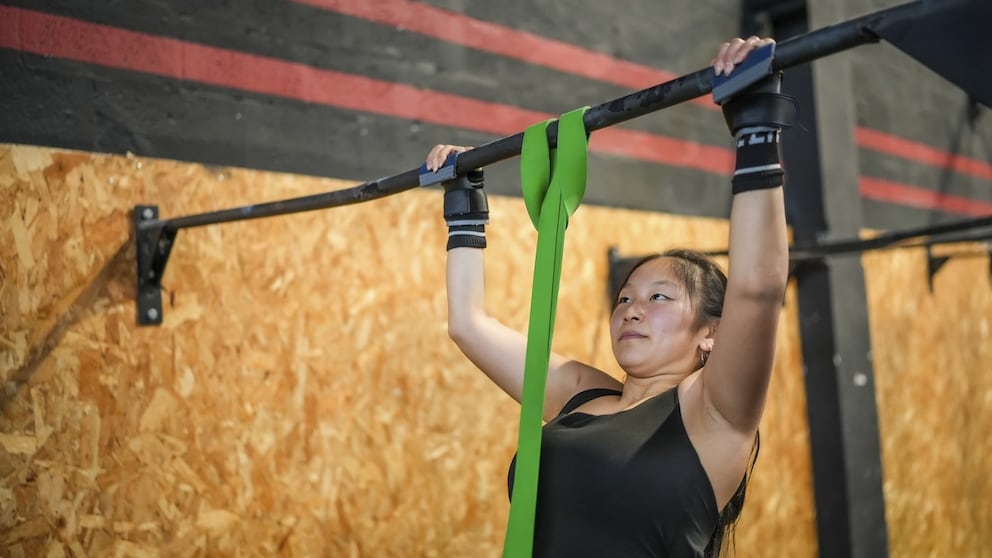March 24, 2025, 8:27 pm | Read time: 5 minutes
Pull-ups are a challenging strength exercise, all the more impressive when you finally master them. Instead of attempting a full pull-up straight away, you can start with preliminary exercises — and use bands to help you. FITBOOK author Nina Ponath explains how this works.
How many pull-ups can you do? One? Two? Or none at all? “Most people who come to me for training can’t do a single pull-up; some can do one to three,” says Andreas Heumann, a personal trainer from Berlin. So, if you are one of those who have just been ashamed to realize that they have to answer “none” — you are not alone! Pull-ups are one of the most challenging self-weight exercises of all. But don’t worry, there’s a solution: pull-ups with a band!
Overview
Why a Band Makes Training Pull-Ups Easier
Resistance bands take some of your body weight off you when you exercise — and that’s not insignificant. Depending on the strength of the band, you will have ten to 70 kilos less body weight. This naturally makes it easier to pull yourself up. In this way, pull-ups can be learned gradually while building up strength at the same time. Personal trainer Andreas Heumann advises gradually preparing for the full load with a resistance band.
How Do You Do Pull-Ups with a Band?
Select a band with the appropriate resistance. This depends on your body weight and how much support you need from the band. There are bands that can support your entire body weight, while others only reduce the weight.
How to Practice Pull-Ups with a Band
- Start with a warm-up for the shoulders.
- Attach the band to the pull-up bar.
- Place one foot or your knee in the band.
- Pull yourself up in a controlled manner until your chin reaches the bar.
- Slowly lower yourself back down.
- Repeat as many pull-ups as you can manage and do a total of three rounds.
- Tip: A band with stronger resistance will provide more support. Start with a high resistance. Gradually reduce the strength of your band until you can do pull-ups without a band at some point.

Shoulder muscles Deltoid muscle – anatomy, function and exercises

Fit Hollywood star How David Boreanaz trains for his series role as a Navy Seal

Actor Paul Mescal “Gladiator II” star: “I ate 5,000 calories a day”
3 Pull-Up Pre-Exercises with a Band
Is your first pull-up still a long way off? No problem. These exercises will give you a strong foundation. Practice the preliminary exercises until you feel slightly under-challenged. Then, the pull-up will be within your reach.
Rowing with Resistance Band
The Benefits of This Exercise
- Rowing with a resistance band strengthens the back muscles (especially the latissimus dorsi and rhomboids), which are essential for pull-ups.
- It also improves pulling power and trains shoulder blade control, which is crucial for the correct pull-up technique.
Execution
- Attach the resistance band to a stable object at chest height (e.g., a pull-up bar or a door anchor).
- Grasp the band with both hands, palms facing each other or inwards.
- Take a few steps back until the band is under tension.
- Bend your knees slightly and keep your back straight.
- Pull the band towards your chest by pulling your elbows back and pulling your shoulder blades together.
- Hold the position briefly and then slowly return to the starting position.
- Repeat the exercise for three sets of ten to twelve repetitions.
Scapular Pull-Ups with Band
Why Do This Exercise?
Scapular pull-ups focus on the movement of the shoulder blades, which is essential for the correct pull-up technique. “Many people can’t control their shoulders properly,” says personal trainer Andreas Heumann. This variation strengthens the muscles that control the shoulder blades and thus improves the stability of the shoulder joint. Gradually, the correct movement of the shoulder blades can be learned.
Execution
- Attach the resistance band to the pull-up bar so that you can hold on to it.
- Grip the bar with a pull-up grip (overhand grip: palms facing away from you).
- Hang from the bar with your arms straight.
- Pull your shoulder blades down and together without bending your elbows.
- Hold the position briefly and then slowly return to the starting position.
- Repeat the exercise for three sets of ten to twelve repetitions.
Negative Pull-Ups with Band Support
Why Do This Exercise?
Negative pull-ups focus on the descending phase of the pull-up, which is often neglected. They strengthen the muscles responsible for controlling the downward movement and improve strength endurance. Due to the support of the band, which reduces body weight, this exercise can be performed by almost anyone.
Execution
- Attach the resistance band to the pull-up bar.
- Place one foot or knee in the band for support.
- Use the band to pull yourself up until your chin reaches the bar.
- Then, lower yourself down slowly and in a controlled manner, engaging your muscles.
- Repeat the exercises for three sets of five to eight repetitions.

